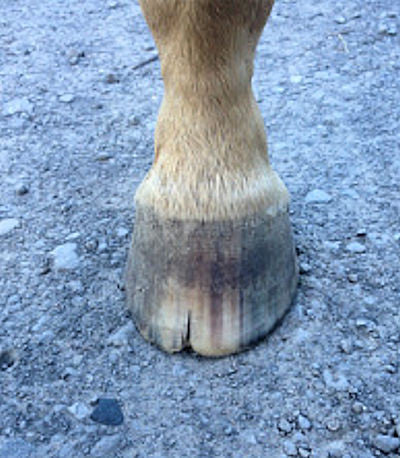
Seedy Toe
Share
"Seedy-toe and white line disease (WLD) are simply different names describing similar infections. Seedy toe and WLD look the same and involve the same opportunistic fungal and bacterial invaders. Neither are primary hoof diseases; both are secondary problems caused by mechanical hoof problems or whole-horse health issues." -Paige Poss
Well, that's it in a nutshell (in a hoof? bad pun - sorry! )
So, simply put in another way, the hoof has become compromised as to allow opportunistic fungal and bacteria to invade the wall.
How does this happen?
It occurs from trimming issues where the walls of the hooves are not taken back far enough to avoid leverage from the ground bearing load upon the wall. Much like your or my fingernail ... could you imagine trying to walk on that? The nail would be torn apart from the nail bed faster than one could say OW! That would then open up the finger to infections ... not too much different than overly long toes on the horse's hoof.

Now take a look here:  Healthy, well maintained fingernails that are not going to receive undue pressure or leverages.
Healthy, well maintained fingernails that are not going to receive undue pressure or leverages.
Compare to hooves:
 Long toed. Just imagine the pressure on the wall while that hoof is loading and unloading.
Long toed. Just imagine the pressure on the wall while that hoof is loading and unloading.
 Healthy, strong, solid hoof wall.
Healthy, strong, solid hoof wall.
Now some may say it's impossible to compare long fingernails to long toed hooves. It's for analogy, only. To perk up your visualizations so you can imagine the pain that long toed horses have to endure AND understand how excess wall can leverage the wall right away from the white line and allow bacteria and fungus to invade the foot.
Now, that being said, there are other factors, besides mechanics (hoof trimming and care) that can contribute to Seedy Toe.
A strong immune system in the horse will help prevent bacteria and fungus from taking up residence anywhere in the body; that's the 'natural' function of the immune system. When we FEED the horse, we are FEEDING the IMMUNE system. 70+% of the immune system lies within the gut. In order for the gut to properly function it needs a balance of the proper GOOD bacteria to help breakdown and utilize the nutrients from the diet.
Bacteria and Fungus THRIVE in an acidic environment. ... too much SUGAR in the system causes excess acid. A hoof that is shelly, weak, cracking, splitting, poor horn quality ... all scream out imbalanced gut = imbalanced immune system. Sweet feeds, feeds with "flavor enhancers for palatibility" (Molasses), starch, carbohydrates ... they all cause acidic conditions in the gut.
What goes INTO the horse GROWS OUT in the hooves! (and skin, and coat, and teeth, and affects behavior -- heck, affects the WHOLE HORSE)
Lastly, but not least, is MOVEMENT.
The horse is created to M.O.V.E. ... lots and lots of moving. Miles a day - up to 20 or 30 miles within a 24 hour period of time.
Over VARIED terrain ... rocky, sandy, grassy, wet, dry, soft, hard.
Most domestic horses are not afforded that movement. Many are confined in small paddocks of dirt and a 12 foot by 12 foot stall with no way to get out of their own waste to eat. No way to gallop over abrasive ground to harden and strengthen the hooves. No way to eat live, green, chlorophyll-rich forages. No way to 'graze' forage or hay 24/7.
All of this - I repeat, ALL of it affects the hooves.
So, a quick synopsis of how to treat Seedy Toe? If you see your horse has a hole in the toe or a separation of the wall from the white line, get a good trim that helps to relieve the leverage on the toe. Take a good look at your horse's diet and inspect your husbandry. Does your horse have a dry place to stand (or, in the case of arid areas, does he have a wet place to stand)? Are his quarters clear of manure and urine? Does he get any 'social' activity with other horses? How much does this horse move? Treat the issue topically but also consider the whole of the rest of it.
One more thing .. there are many caustic products on the market that promise to get rid of bacteria and fungus in the hooves. While many do a good job, without looking at the rest of the horse, the WHOLE horse, the topical 'fix' will only be temporary. There are strong, extremely effective "natural" products that, when used in conjunction with healthy diet and thoughtful husbandry practices, will address not only the Seedy Toe but also the rest of the horse so as to eradicate the ROOT cause of the issue. If the root cause is not tended then the situation will only rise up again.
Building a Supportive Barefoot Community
The team at Scoot Boot believe passionately in the barefoot horse and strive to build a supportive community of barefoot horse lovers.
Find more information about using Scoot Boots here.

Gwen Santagate is the author of "10 Secrets to Healthy Hooves" . For the last 37+ years, she has maintained healthy hooves with natural trimming on thousands of horses and specialized in pathological rehabilitation hoofcare for the last 18 years. She keeps a small herd of her own equines and continues to offer consults for horses in need.

